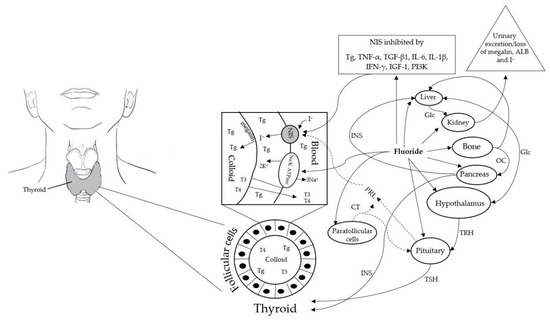Abstract
The sodium iodide symporter (NIS) is the plasma membrane glycoprotein that mediates active iodide transport in the thyroid and other tissues, such as the salivary, gastric mucosa, rectal mucosa, bronchial mucosa, placenta and mammary glands. In the thyroid, NIS mediates the uptake and accumulation of iodine and its activity is crucial for the development of the central nervous system and disease prevention. Since the discovery of NIS in 1996, research has further shown that NIS functionality and iodine transport is dependent on the activity of the sodium potassium activated adenosine 5′-triphosphatase pump (Na+, K+-ATPase). In this article, I review the molecular mechanisms by which F inhibits NIS expression and functionality which in turn contributes to impaired iodide absorption, diminished iodide-concentrating ability and iodine deficiency disorders. I discuss how NIS expression and activity is inhibited by thyroglobulin (Tg), tumour necrosis factor alpha (TNF-?), transforming growth factor beta 1 (TGF-?1), interleukin 6 (IL-6) and Interleukin 1 beta (IL-1?), interferon-? (IFN-?), insulin like growth factor 1 (IGF-1) and phosphoinositide 3-kinase (PI3K) and how fluoride upregulates expression and activity of these biomarkers. I further describe the crucial role of prolactin and megalin in regulation of NIS expression and iodine homeostasis and the effect of fluoride in down regulating prolactin and megalin expression. Among many other issues, I discuss the potential conflict between public health policies such as water fluoridation and its contribution to iodine deficiency, neurodevelopmental and pathological disorders. Further studies are warranted to examine these associations.

 Figure 1
Figure 1